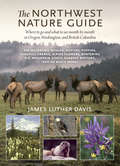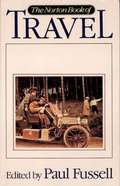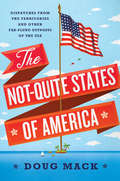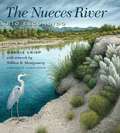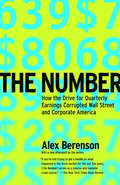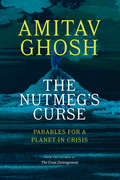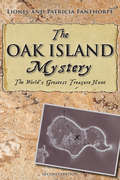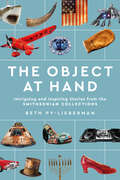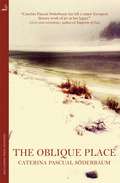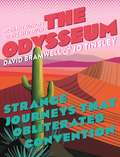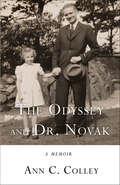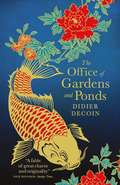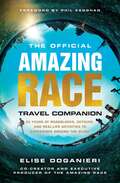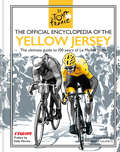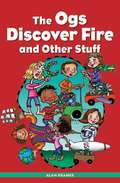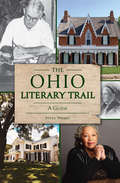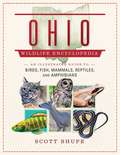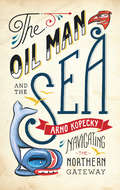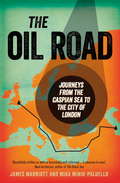- Table View
- List View
The Northwest Nature Guide: Where to Go and What to See Month by Month in Oregon, Washington, and British Columbia
by James Luther DavisFrom winter whale watching to autumn seabirding, The Northwest Nature Guide offers more than 170 best bets for wildlife adventures throughout Oregon, Washington, and British Columbia—as well as your own backyard. With contagious enthusiasm and irrepressible humor, James Luther Davis shares his insider tips, helpful maps, and experience to guarantee readers know where they need to go to see nature at its peak every month of the year. Whatever the season and no matter the weather, Davis entices nature lovers of all ages to discover what they might otherwise miss. The intrepid may find the three-toed woodpecker or even Sasquatch. The inquisitive will learn why auks fly but penguins don't. Everyone will discover outdoor adventures that revitalize, inspire, and renew their appreciation for nature. Whether it's tidepooling by the shore, newt pursuit in the woods, or trailing bighorn sheep in the mountains, this practical guide helps make the most of every fresh-air opportunity.
The Norton Book of Travel
by Paul FussellEditor Paul Fussell has brought together some of the best travel writing of all time from the world's most recognized travelers -- Marco Polo, Darwin and Kerouac to name a few -- and has explored the traveler's psyche from the Age of Discovery to the Age of Mass Tourism.
The Not-Quite States of America: Dispatches from the Territories and Other Far-Flung Outposts of the USA
by Doug MackAn eye-opening journey to the most overlooked parts of America. Everyone knows that America is 50 states and…some other stuff. Scattered shards in the Pacific and the Caribbean, the not-quite states—American Samoa, Guam, Puerto Rico, the Northern Mariana Islands, and the U.S. Virgin Islands—and their 4 million people are often forgotten, even by most Americans. But they’re filled with American flags, U.S. post offices, and Little League baseball games. How did these territories come to be part of the United States? What are they like? And why aren’t they states? When Doug Mack realized just how little he knew about the territories, he set off on a globe-hopping quest covering more than 30,000 miles to see them all. In the U.S. Virgin Islands, Mack examines the Founding Fathers’ arguments over expansion. He explores Polynesia’s outsize influence on American culture, from tiki bars to tattoos, in American Samoa. He tours Guam with members of a military veterans’ motorcycle club, who offer personal stories about the territory’s role in World War II and its present-day importance for the American military. In the Northern Mariana Islands, he learns about star-guided seafaring from one of the ancient tradition’s last practitioners. And everywhere he goes in Puerto Rico, he listens in on the lively debate over political status—independence, statehood, or the status quo. The Not-Quite States of America is an entertaining account of the territories’ place in the USA, and it raises fascinating questions about the nature of empire. As Mack shows, the territories aren’t mere footnotes to American history; they are a crucial part of the story.
The Nueces River: Río Escondido (River Books)
by Margie CrispFirst appearing on early Spanish maps as the Río Escondido, or hidden river, and later named Río de las Nueces after the abundant pecan trees along its banks, the Nueces today is a stream of seeming contradictions: a river that runs above and below ground; a geographic reminder of a history both noble and egregious; and a spring-fed stream transformed into a salty, steep-sided channel. <P><P>From its fresh, clear headwaters on the Edwards Plateau, Margie Crisp and William B. Montgomery follow the river through the mesquite and prickly pear of the South Texas Plains, to the river’s end in Nueces and Corpus Christi Bays on the Gulf of Mexico. With vivid prose and paintings, they record their travels as they explore the length of the river on foot, kayak, and fishing boat, ultimately weaving a vivid portrait of today’s Nueces. Capturing the river’s subtle beauty, abundant wildlife, diverse culture, and unique history of exploration, conflict, and settlement, they reveal the untold story of this enigmatic river with passion, humor, and reverence.
The Number: Why Companies Lied And The Stock Market Crashed
by Alex BerensonWith a new Afterword by the author and a new Foreword by Mark Cuban In this commanding big-picture analysis of what went wrong in corporate America, Alex Berenson, a top financial investigative reporter for The New York Times, examines the common thread connecting Enron, Worldcom, Halliburton, Computer Associates, Tyco, and other recent corporate scandals: the cult of the number. Every three months, 14,000 publicly traded companies report sales and profits to their shareholders. Nothing is more important in these quarterly announcements than earnings per share, the lodestar that investors--and these days, that's most of us--use to judge the health of corporate America. earnings per share is the number for which all other numbers are sacrificed. It is the distilled truth of a company's health. Too bad it's often a lie. Alex Berenson's The Number provides a comprehensive, brutally factual overview of how Wall Street and corporate America lost their way during the great bull market that began in 1982. With wit and a broad historical perspective, Berenson puts recent corporate accounting (or accountability) disasters in their proper context. He explains how the wheels came off the wagon, giving readers the information and analysis they need to understand Enron, Tyco, WorldCom, Halliburton, and the rest of the corporate calamities of our times.
The Nutmeg's Curse: Parables for a Planet in Crisis
by Amitav GhoshThe author of The Great Derangement finds the origins of our climate crisis in Western colonialism&’s violent exploitation of human life and the environment. A powerful work of history, essay, testimony, and polemic, Amitav Ghosh&’s new book traces our contemporary planetary crisis back to the discovery of the New World and the sea route to the Indian Ocean. The Nutmeg&’s Curse argues that the dynamics of climate change today are rooted in a centuries-old geopolitical order constructed by Western colonialism. At the center of Ghosh&’s narrative is the now-ubiquitous spice nutmeg. The history of the nutmeg is one of conquest and exploitation—of both human life and the natural environment. In Ghosh&’s hands, the story of the nutmeg becomes a parable for our environmental crisis, revealing the ways human history has always been entangled with earthly materials such as spices, tea, sugarcane, opium, and fossil fuels. Our crisis, he shows, is ultimately the result of a mechanistic view of the earth, where nature exists only as a resource for humans to use for our own ends, rather than a force of its own, full of agency and meaning. Writing against the backdrop of the global pandemic and the Black Lives Matter protests, Ghosh frames these historical stories in a way that connects our shared colonial histories with the deep inequality we see around us today. By interweaving discussions on everything from the global history of the oil trade to the migrant crisis and the animist spirituality of Indigenous communities around the world, The Nutmeg&’s Curse offers a sharp critique of Western society and speaks to the profoundly remarkable ways in which human history is shaped by non-human forces.
The Nyonya Kebaya
by Datin SeriThis longtime Malaysian fashion icon was originally a long, straight, Arab-inspired top of plain woven cotton. <P><P>The Nyonyas, the women of the early Peranakan community, gradually transformed it into a shapely, embroidered, translucent blouse, fastened with a set of chained brooches and worn with a matching hand-drawn batik sarong.Sheer, romantic, alluring, yet sedate, the designs of Nyonya kebaya crosses several generations and cultures.This book showcases the collection of Datin Seri Endon Mahmood, wife of the Prime Minister of Malaysia.
The Oak Island Mystery: The Secret of the World's Greatest Treasure Hunt
by Patricia Fanthorpe Lionel FanthorpeThe Oak Island mystery has been the world’s greatest and strangest treasure hunt, and after years of research the authors have finally solved the sinister with an answer that is challenging, controversial, and disturbing. In 1795 three boys discovered the top of an ancient shaft on uninhabited Oak Island in Mahone Bay, Nova Scotia. The boys began to dig, and what they uncovered started the world’s greatest and strangest treasure hunt but nobody knows what the treasure is. Two hundred years of courage, back-breaking effort, ingenuity, and engineering skills have failed to retrieve what is concealed there. Theories of what the treasure could be include Captain Kidd’s bloodstained pirate gold, an army payroll left by the French or British military engineers, priceless ancient manuscripts, the body of an Arif or other religious refugee leader, or the lost treasure of the Templars. The Oak Island curse prophesies that the treasure will not be found until seven men are dead and the last oak has fallen. That last oak has already gone, and six treasure hunters have been killed. After years of research, the authors have finally solved the sinister riddle of Oak Island, but their answer is challenging, controversial, and disturbing. Something beyond price still lies waiting in the labyrinth.
The Oatmeal Ark: Across Canada by Water
by Rory MacleanThe Oatmeal Ark weaves invention through true stories, stitches imaginary characters into real events. It is at once a history and a fiction. It tries to reach beyond our tradition of realistic literature, building on the strengths of Susanna Moodie, the Canadian Vegetable and the NFB documentary, and to reassert the older mythical dimensions of the land. In my writing I strive to cross the line beyond which fact becomes myth to find a truth that is made sharper in fiction. The Oatmeal Ark is a subjective, heartfelt look at Canada, its history and the courageous men and women of all nationalities who struggled -- and struggle still -- to build this country.
The Object at Hand: Intriguing and Inspiring Stories from the Smithsonian Collections
by Beth Py-LiebermanFrom Dorothy's ruby slippers to a speech that saved Teddy Roosevelt from assassination, this authoritative guide delivers in-depth reportage on the history of remarkable objects from the Smithsonian's collectionsFor American history, pop culture, and museum enthusiastsWith charm and exuberance, The Object at Hand presents a behind-the-scenes vantage point of the Smithsonian collections. Veteran Smithsonian magazine editor Beth Py-Lieberman weaves together adaptations of the magazine's extensive and compelling coverage and interviews with scholars, curators, and historians to take readers on an unforgettable journey through the Smithsonian museums.Objects are grouped into the themes audacity, utopia, fierce, haunting, deception, lost, desire, triumph, scale, optimism, playful, rhythm, and revealing to engage with the emotional dimensions of each object, how they relate to each other, and how they fit into the larger American story. A sampling includes: The Star-Spangled Banner Frida Kahlo's love letter to Diego RiveraAmelia Earhart's Lockheed Vega 5BNat Turner's BibleAn AIDS quilt panel honoring Roger Gail LyonA signpost from the Standing Rock protest A glass-plate portrait of Abraham Lincoln Life-sized model of a MegalodonThe Hope DiamondChuck Berry's CadillacPortrait of Henrietta LacksPy-Lieberman reflects on the profound connections between even outwardly dissimilar objects, and offers insight and stories from Smithsonian experts. The book explores artworks, scientific specimens, historical artifacts, airplanes, spacecraft, plants, and so much more, contemplating how each item represents different facets of humanity and resonates with cultural meaning in surprising ways. Whimsical, affecting, and insightful, The Object at Hand offers an intimate and exclusive tour of the Smithsonian collections.
The Oblique Place
by Caterina Pascual Söderbaum"Caterina Pascual Söderbaum has left a major European literary work of art as her legacy" STEVE SEM-SANDBERG, author of Emperor of LiesThe Oblique Place is a captivating journey of the imagination, a prize-winning novel that probes the ruinous legacies of Fascist Europe in the twentieth century.The discovery of photographs in an album - of her Spanish grandfather who joined Hitler's Wehrmacht and her father in the uniform of Franco's army- leads Caterina Pascual Söderbaum to explore her family's links to some of the most abhorrent passages of twentieth-century history. Her mother turns out to be related to Kristina Söderbaum, a celebrated Swedish film star of the Third Reich, adored by Goebbels.She travels with husband and child to the shores of the idyllic Attersee in Austria, where the officers of the extermination camps spent their holidays. The journey continues from Schloss Hartheim, where the staff of the Nazi euthanasia programme forgot, with the help of alcohol and sex, the horrors that took place there, to the Villa Saint-Jean, where malnourished children from France's internment camps were sent to recover. This imaginative rediscovery of her own family's disturbing history is fused with vividly captured episodes from other lives and times, and the threads of evil that she lays bare are described in language so beautiful, so subtle and painterly, that her odyssey is at once shattering and mesmerising.Translated from the Swedish by Frank Perry
The Oblique Place (MacLehose Press Editions #14)
by Caterina Pascual Söderbaum"Caterina Pascual Söderbaum has left a major European literary work of art as her legacy" STEVE SEM-SANDBERG, author of Emperor of LiesThe Oblique Place is a captivating journey of the imagination, a prize-winning novel that probes the ruinous legacies of Fascist Europe in the twentieth century.The discovery of photographs in an album - of her Spanish grandfather who joined Hitler's Wehrmacht and her father in the uniform of Franco's army- leads Caterina Pascual Söderbaum to explore her family's links to some of the most abhorrent passages of twentieth-century history. Her mother turns out to be related to Kristina Söderbaum, a celebrated Swedish film star of the Third Reich, adored by Goebbels.She travels with husband and child to the shores of the idyllic Attersee in Austria, where the officers of the extermination camps spent their holidays. The journey continues from Schloss Hartheim, where the staff of the Nazi euthanasia programme forgot, with the help of alcohol and sex, the horrors that took place there, to the Villa Saint-Jean, where malnourished children from France's internment camps were sent to recover. This imaginative rediscovery of her own family's disturbing history is fused with vividly captured episodes from other lives and times, and the threads of evil that she lays bare are described in language so beautiful, so subtle and painterly, that her odyssey is at once shattering and mesmerising.Translated from the Swedish by Frank Perry
The Observer: Letters from Oklahoma Territory (Voices of America)
by Kenneth J. PeekR.H. Wessel was the owner, editor, and publisher of the Frederick Enterprise / Frederick Press, and a leading citizen from the day he first came to Frederick, Oklahoma, in 1902 until his death in 1956. He is best known for his column "The Observer," for which this book is titled. He left behind a considerable legacy of his adventurous life through letters, photographs, documents, and historic files. His experiences in Lawton during the 1901 Land Lottery and the following homestead years in Frederick are covered in this book.As a newspaperman, with a love for telling a story, his letters are an incredible documentation of life on the Oklahoma frontier, as well as his love story by mail with Margaret Scow, the bride he brought to Oklahoma after "proving up" on his homestead and obtaining his own newspaper.
The Ocean is Calling: A True Story of Love and Loss by the Sea
by Ashley BuggeAs a young widow, Ashley Bugge was suddenly faced with the task of raising two young children and a newborn child without the support of her spouse. Could she do it alone? The Ocean is Calling exposes the realities of a life’s greatest love and loss: the unexpected death of a spouse, followed by giving birth to a child, alone. Facing insurmountable grief, Ashley Bugge takes readers through a journey like no other—from a bitter dark night with a bottle of sleeping pills in her hand to giving birth alone, to a no-holds-barred expedition through eight countries with her three young children in tow.Ashley holds nothing back as she includes readers on her real-time voyage through incredible states, countries and oceans. She shares daring, challenging moments of donning scuba diving gear to explore the same water her husband took his last breath, traversing mountains in Switzerland, exploring WWII remains in Poland, and grappling with the struggles of a young widow raising three children on her own. The Ocean is Calling shares a journey of heartache, discovery, travel, family and exploration. Ashley hopes that her story will encourage readers to be confident and trust that whatever happens in life, there is hope and joy ahead.
The Odysseum: Strange journeys that obliterated convention
by David Bramwell Jo TinsleyExplore the extraordinary stories behind some of the greatest - and strangest - adventures and explorations in human history.
The Odyssey and Dr. Novak: A Memoir
by Ann C. ColleyOne summer afternoon in northern England in 1946, when Ann Colley was a child, she met a man from Czechoslovakia named Dr. Novak. This encounter launched her lifelong fascination with Central and Eastern Europe, one that resulted in her spending two years, in 1995 and 2000, teaching at universities in Poland and Ukraine. In The Odyssey and Dr. Novak, Colley records personal experiences, interactions with colleagues, and descriptions of the landscape, creating a composite portrait of these countries at a time when each is struggling to chart its course after the collapse of the Soviet Union in 1991. She recalls moments that are disturbing, absurd, discordant, frustrating, humorous, and endearing—a missing parrot flying in through the window; a robber on a train threatening her life; clouds of smoke from Chernobyl hanging over Kiev. Colley’s journey ends with her return to the figure of Dr. Novak when she searches in the archives of the Harvard Divinity School Library for letters sent from Prague in 1945—letters which, just like her memoir, speak of a past that pursues the present.
The Office of Gardens and Ponds
by Didier DecoinA mesmerising fable with a difference, set in Japan over 1000 years agoFor readers of Alessandro Baricco's Silk, Patrick Süskind's Perfume and Takashi Hiraide's The Guest Cat.The village of Shimae is thrown into turmoil when master carp-catcher Katsuro suddenly drowns in the murky waters of the Kusagawa river. Who now will carry the precious cargo of carp to the Imperial Palace and preserve the crucial patronage that everyone in the village depends upon?Step forward Miyuki, Katsuro's grief-struck widow and the only remaining person in the village who knows anything about carp. She alone can undertake the long, perilous journey to the Imperial Palace, balancing the heavy baskets of fish on a pole across her shoulders, and ensure her village's future.So Miyuki sets off. Along her way she will encounter a host of remarkable characters, from prostitutes and innkeepers, to warlords and priests with evil in mind. She will endure ambushes and disaster, for the villagers are not the only people fixated on the fate of the eight magnificent carp. But when she reaches the Office of Gardens and Ponds, Miyuki discovers that the trials of her journey are far from over. For in the Imperial City, nothing is quite as it seems, and beneath a veneer of refinement and ritual, there is an impenetrable barrier of politics and snobbery that Miyuki must overcome if she is to return to Shimae.
The Official Amazing Race Travel Companion: More Than 20 Years of Roadblocks, Detours, and Real-Life Activities to Experience Around the Globe
by Elise DoganieriDiscover unique destinations and take your vacation plans to the next level with these travel ideas from the official companion to the blockbuster reality show, The Amazing Race. For more than twenty years, The Amazing Race has introduced viewers to unique travel destinations in ninety-two countries across the globe. Pairing challenges with cultural touchpoints of the locations visited, The Amazing Race averages 10 million viewers per season. This fanbook-meets-travel guide will cover six continents and thirty-two countries, including activities and places to visit at each destination. In addition to region-specific recommendations of destinations and activities from the show&’s history, The Official Amazing Race Travel Companion will feature: -A never-before-seen &“behind the scenes&” snapshot of how the show is made, who they hire, and how destinations are chosen -An introduction by Elise Doganieri and Bertram van Munster, cocreators of The Amazing Race -A foreword by host Phil Keoghan -And many more fun surprises! Perfect for the fan or avid traveler in your life, The Official Amazing Race Travel Companion will satisfy any craving for adventure while traveling! TM Amazing Race Productions Inc. © 2022 Amazing Race Productions Inc. & ABC Studios Inc. All Rights Reserved.
The Official Encyclopedia of the Yellow Jersey: 100 Years of the Yellow Jersey (Maillot Jaune)
by Frédérique Galametz Philippe BouvetThe must-have encyclopedia for all Tour de France fans.Celebrating the centenary of cycling's most iconic award, The Official Encyclopedia of the Yellow Jersey is a visually stunning and comprehensive look at all the wearers of the 'maillot jaune'. In this book, acclaimed L'Équipe journalists Philippe Bouvet and Frédérique Galametz bring to life the 100-year history of spectacular sporting achievement, covering incredible stories from the 'Hall of Fame' including five-time winner Miguel Indurain, and statistics on the yellow jersey, the 266 race leaders who have worn it and much more. This book includes:- A preface from 11-time Grand Tour winner, Eddy Merckx- A look at the rise of the British reign since 2012, with Wiggins, Froome and Thomas - All the official statistics established by L'Équipe (the no.1 French sports newspaper) and used by the Tour de France, from the yellow jersey winners by country, to the 'National Firsts' - the first riders from each nation to wear the yellow jersey- Photographs and biographies of all the successive yellow jersey wearers over the past 100 years, from the first wearer, Eugène Christophe, to the 2018 Tour de France and yellow jersey winner, Geraint ThomasThe perfect guide for all those with a passion for sport.
The Official Encyclopedia of the Yellow Jersey: 100 Years of the Yellow Jersey (Maillot Jaune)
by Frédérique Galametz Philippe BouvetThe must-have encyclopedia for all Tour de France fans.Celebrating the centenary of cycling's most iconic award, The Official Encyclopedia of the Yellow Jersey is a visually stunning and comprehensive look at all the wearers of the 'maillot jaune'. In this book, acclaimed L'Équipe journalists Philippe Bouvet and Frédérique Galametz bring to life the 100-year history of spectacular sporting achievement, covering incredible stories from the 'Hall of Fame' including five-time winner Miguel Indurain, and statistics on the yellow jersey, the 266 race leaders who have worn it and much more. This book includes:- A preface from 11-time Grand Tour winner, Eddy Merckx- A look at the rise of the British reign since 2012, with Wiggins, Froome and Thomas - All the official statistics established by L'Équipe (the no.1 French sports newspaper) and used by the Tour de France, from the yellow jersey winners by country, to the 'National Firsts' - the first riders from each nation to wear the yellow jersey- Photographs and biographies of all the successive yellow jersey wearers over the past 100 years, from the first wearer, Eugène Christophe, to the 2018 Tour de France and yellow jersey winner, Geraint ThomasThe perfect guide for all those with a passion for sport.
The Ogs Discover Fire and Other Stuff: Set of 6 (Navigators Ser.)
by Alison Adams Alan Kramer Anita DuFallaNIMAC-sourced textbook
The Ohio Literary Trail: A Guide (History & Guide)
by Betty WeibelThe Ohio Literary Trail celebrates the Buckeye State's role in shaping culture and literature worldwide. Along the trail, developed by the Ohioana Library Association, lie historic homes, museums, library collections and historical markers honoring great authors, poets and influencers of the literary landscape. Following the state's five geographic regions for convenient self-guided tours, curious explorers can walk in the footsteps of Harriet Beecher Stowe and poet Paul Laurence Dunbar. They can view renowned collections of comics, picture book art and Nancy Drew-themed artifacts. Or they can tour the home and farm of Pulitzer Prize winner and conservationist Louis Bromfield. Compiled with care by Betty Weibel, one of the trail's creators, this guide offers something unique for the armchair traveler and the road warrior alike.
The Ohio Wildlife Encyclopedia: An Illustrated Guide to Birds, Fish, Mammals, Reptiles, and Amphibians
by Scott ShupeOhio’s wildlife has always played an important role in the history of human beings inhabiting the state. Native Americans depended on birds, mammals, and fish for sustenance and the state’s first Europeans came in search of Beaver and buckskins. Although the state’s wildlife is still an important resource for human consumption, wildlife is also increasingly important in today’s culture for its intrinsic, aesthetic value. For many Ohioans, the age-old traditions of hunting and fishing have been replaced by a desire to simply observe wildlife and experience nature. But most Ohioans are largely unaware of the diversity of species inhabiting their state. This volume is intended to provide an introduction to the state’s fishes, amphibians, reptiles, birds, and mammals.In The Ohio Wildlife Encyclopedia, nationally known naturalist Scott Shupe has collected information on all the wildlife that reside in the Buckeye State. The first in a series of state wildlife encyclopedias, this book will be a handy, usable, layman’s guide to Ohio’s wildlife.Included are over 800 color photographs, depicting the different species of mammals, reptiles, amphibians, birds, and fish, while also offering over 600 range maps to show their territory. Along with basic information for the biology of each animal, Shupe includes the size, habitat, and abundance of each species located in the state.Whether you’re a lover of the outdoors, photography, or are looking to learn more about your state, this comprehensive guide will teach you about the wonderful wildlife that covers the water, earth, and skies of Ohio.
The Oil Man and the Sea: Navigating the Northern Gateway
by Arno KopeckyA sailing trip along the proposed Northern Gateway marine route with a fresh new voice in non-fiction.With oil and gas behemoth Enbridge Inc.'s Northern Gateway proposal nearing approval, supertankers loaded with two million barrels of oil may soon be plying the waters from northern British Columbia down the wild Pacific Coast. <P><P>This region is home to the largest tract of temperate rainforest on earth, First Nations who have lived there for millennia, and some of the world's most biodiverse waters-one spill is all it will take to erase ten thousand years of evolution.Arno Kopecky and his companions travel aboard a forty-one-foot sailboat exploring the pristine route-a profoundly volatile marine environment that registered 1,275 marine vessel incidents-mechanical failures, collisions, explosions, groundings, and sinkings-between 1999 and 2009 alone. Neither Kopecky nor the boat's owner have ever sailed before, yet they brave these waters alone when their captain leaves them part way through the journey.Written with Kopecky's quick humor and deft touch, this is a rich evocation of a mythic place and the ecology, culture, and history of a legendary region with a knife at its throat.
The Oil Road
by Mika Minio-Paluello James MarriottFrom Caspian drilling rigs and Caucasus mountain villages to Mediterranean fishing communities and European capitals, this is a journey through the heart of our oil-obsessed society. Blending travel writing and investigative journalism, it charts a history of violent confrontation between geopolitics, profit and humanity. From the revolutionary futurism of 1920s Baku to the unblinking capitalism of modern London, this book reveals the relentless drive to control fossil fuels. Harrowing, powerful and insightful, The Oil Road maps the true cost of oil.
